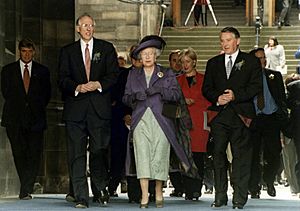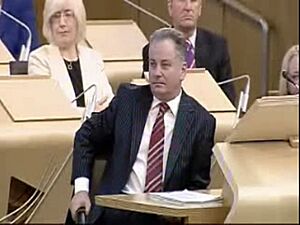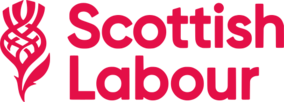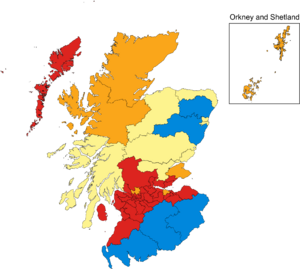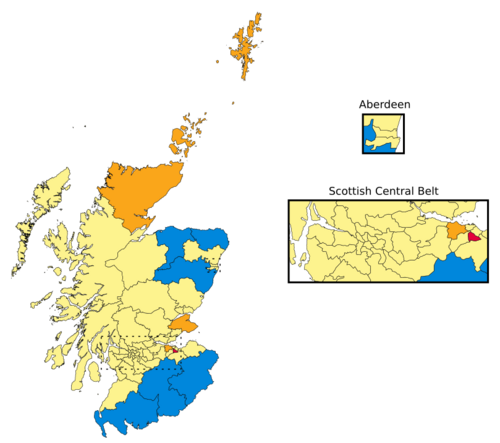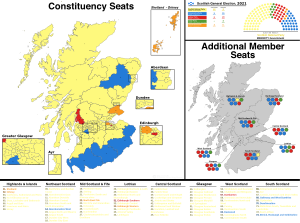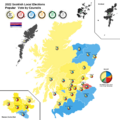Scottish Labour facts for kids
Quick facts for kids
Scottish Labour
Pàrtaidh Làbarach na h-Alba
|
|
|---|---|
 |
|
| Leader | Anas Sarwar |
| Deputy Leader | Jackie Baillie |
| General Secretary | Kate Watson |
| Founder | Robert Bontine Cunninghame Graham Keir Hardie |
| Founded | 1888 (original form) 1994 (current form) |
| Preceded by | Scottish Labour Party (1888) |
| Headquarters | Rutherglen, South Lanarkshire, Scotland |
| Student wing | Scottish Labour Students |
| Youth wing | Scottish Young Labour |
| Membership (2021) | |
| Ideology |
|
| Political position | Centre-left |
| UK Parliament affiliation | Labour Party (UK) |
| Colours | Red |
| House of Commons (Scottish seats) |
37 / 57
|
| Scottish Parliament |
23 / 129
|
| Local government in Scotland |
268 / 1,227
|
| Councils led in Scotland |
9 / 32
|
| Election symbol | |
 |
|
Scottish Labour (in Scottish Gaelic: Pàrtaidh Làbarach na h-Alba) is a major political party in Scotland. It is the Scottish part of the main Labour Party in the United Kingdom. The party believes in social democracy, which means it works to create a fairer society for everyone. It also supports Scotland remaining part of the United Kingdom.
For many years, from the 1960s to the 2010s, Scottish Labour was the most popular party in Scotland. It won the most seats in every UK general election and European election held during that time. When the Scottish Parliament was created in 1999, Scottish Labour formed the first government in a partnership with the Scottish Liberal Democrats.
However, the party's popularity declined, especially after the 2014 Scottish independence referendum. Many of its voters began to support the Scottish National Party (SNP), which wants Scotland to be an independent country. In the 2015 UK general election, Scottish Labour had one of its worst results ever, losing 40 of its 41 seats in the House of Commons.
The party's support continued to fall in the following years. But in the 2024 UK general election, Scottish Labour made a huge comeback. It won 37 out of 57 Scottish seats, becoming the largest party in Scotland at Westminster for the first time in over a decade.
Contents
How the Party is Organised
Scottish Labour is part of the UK Labour Party but has its own structure to make decisions on Scottish issues. It is run by the Scottish Executive Committee (SEC), which includes representatives from party members, elected politicians, and groups like trade unions.
The party's main office is in Glasgow. Each year, members gather for the Scottish Labour conference to discuss ideas and policies.
Party Membership
Labour Party full members (excluding affiliates and supporters)
The number of people who are members of Scottish Labour has changed over the years. In 1997, when the party was very successful, it had around 30,000 members. By 2008, this number had dropped to 17,000.
After the 2015 UK leadership election, membership grew again. By 2018, it reached over 25,000. However, by February 2021, the number of members had fallen to 16,467.
History of Scottish Labour
The Labour Party has been active in Scotland since it was formed in 1900. At first, it was a small party, but it grew when it joined with the Scottish Trades Union Congress in 1909. In 1915, the party created a Scottish Council to help organise its activities in Scotland.
For a long time, Scottish Labour supported the idea of Scottish devolution, which means giving Scotland its own parliament with powers to make decisions on local issues. The party was a key part of the campaign that led to the creation of the Scottish Parliament in 1999.
1999–2007: Leading the Scottish Government
In the first Scottish Parliament election in 1999, Scottish Labour won the most seats. Their leader, Donald Dewar, became the first ever First Minister of Scotland. Labour formed a government with the Scottish Liberal Democrats.
After Dewar's death in 2000, Henry McLeish became the new First Minister. He was followed by Jack McConnell in 2001. Under McConnell, Labour and the Liberal Democrats won the 2003 election and continued to govern Scotland.
2007–2014: Becoming the Opposition
In the 2007 election, Scottish Labour lost its position as the largest party. The Scottish National Party (SNP) won one more seat than Labour and formed the new government. This meant Labour became the main opposition party at Holyrood for the first time.
After the defeat, Jack McConnell resigned as leader. He was replaced by Wendy Alexander, and later by Iain Gray. In the 2011 election, the SNP won a large majority, and Labour's number of seats fell again. Johann Lamont then became the new leader.
2014–2021: A Time of Big Challenges

Scottish Labour played a big role in the 2014 Scottish independence referendum. The party campaigned for Scotland to remain part of the UK. Although the "No" side won the referendum, many traditional Labour voters had switched their support to the SNP.
This led to a huge defeat for Labour in the 2015 UK general election. The party lost 40 of its 41 Scottish seats at Westminster, with only Ian Murray keeping his seat. Jim Murphy, who had become leader just months before, resigned.
Kezia Dugdale took over as leader, but the party's fortunes did not improve. In the 2016 Scottish Parliament election, Labour fell to third place behind the SNP and the Scottish Conservatives.
In the 2017 UK general election, Labour did better than expected, winning back six seats. However, in the 2019 election, they lost these seats again, leaving them with just one MP. Richard Leonard was the party leader during this difficult period.
2021–Present: A New Direction Under Anas Sarwar
In February 2021, Anas Sarwar was elected as the new leader of Scottish Labour. He promised to unite the party and win back the trust of voters. Under his leadership, the party changed its logo from a red rose to a thistle, a national symbol of Scotland.
In the 2022 local elections, Labour overtook the Conservatives to become the second-largest party in local government. In October 2023, the party won an important by-election in Rutherglen and Hamilton West, taking the seat from the SNP.
The 2024 General Election Comeback
The 2024 UK general election was a major turning point for Scottish Labour. The party won 37 of the 57 seats in Scotland, making it the largest Scottish party at Westminster once again. This was a huge increase from the single seat it held before the election.
Following the victory, the UK Labour Party formed a new government. Scottish Labour MP Ian Murray was appointed as the Secretary of State for Scotland, giving Scotland a key voice in the new UK cabinet.
Elected Representatives
Scottish Labour has politicians representing people at different levels of government.
Members of the UK Parliament
As of the 2024 general election, Scottish Labour has 37 Members of Parliament (MPs) in the House of Commons in London. They represent different areas, or constituencies, across Scotland.
Members of the Scottish Parliament
Scottish Labour also has 22 Members of the Scottish Parliament (MSPs) at Holyrood in Edinburgh. They are the third-largest party in the Scottish Parliament.
The party has a "Shadow Cabinet" at Holyrood. This is a team of senior MSPs who are experts on different topics, like health and education. They challenge the Scottish Government's plans and present Labour's alternative ideas.
- Anas Sarwar – Leader of the Scottish Labour Party
- Jackie Baillie – Deputy Leader and Shadow Cabinet Secretary for Health
- Daniel Johnson – Shadow Cabinet Secretary for Economy
- Pam Duncan-Glancy – Shadow Cabinet Secretary for Education
Electoral Performance
This section shows how Scottish Labour has performed in different elections over the years.
UK House of Commons Elections
This table shows the percentage of votes and the number of seats Scottish Labour has won in UK general elections. For many years, it was the top party in Scotland. After a big drop in 2015, the party made a major recovery in 2024.
| Election | % of Vote | Seats Won | Rank |
|---|---|---|---|
| 1997 | 45.6 |
56 / 72
|
1st |
| 2001 | 43.3 |
56 / 72
|
1st |
| 2005 | 39.5 |
41 / 59
|
1st |
| 2010 | 42.0 |
41 / 59
|
1st |
| 2015 | 24.3 |
1 / 59
|
2nd |
| 2017 | 27.1 |
7 / 59
|
3rd |
| 2019 | 18.6 |
1 / 59
|
4th |
| 2024 | 35.3 |
37 / 57
|
1st |
Scottish Parliament Elections
This table shows the results for Scottish Parliament elections. Labour was the largest party in 1999 and 2003, forming the government. Since 2007, it has been an opposition party.
| Election | Total Seats | +/– | Rank | Government |
|---|---|---|---|---|
| 1999 |
56 / 129
|
1st | Lab–LD | |
| 2003 |
50 / 129
|
1st | Lab–LD | |
| 2007 |
46 / 129
|
2nd | Opposition | |
| 2011 |
37 / 129
|
2nd | Opposition | |
| 2016 |
24 / 129
|
3rd | Opposition | |
| 2021 |
22 / 129
|
3rd | Opposition |
Images for kids
See also
- Campaign for Socialism


